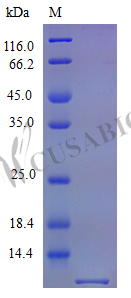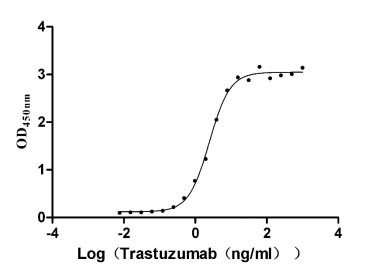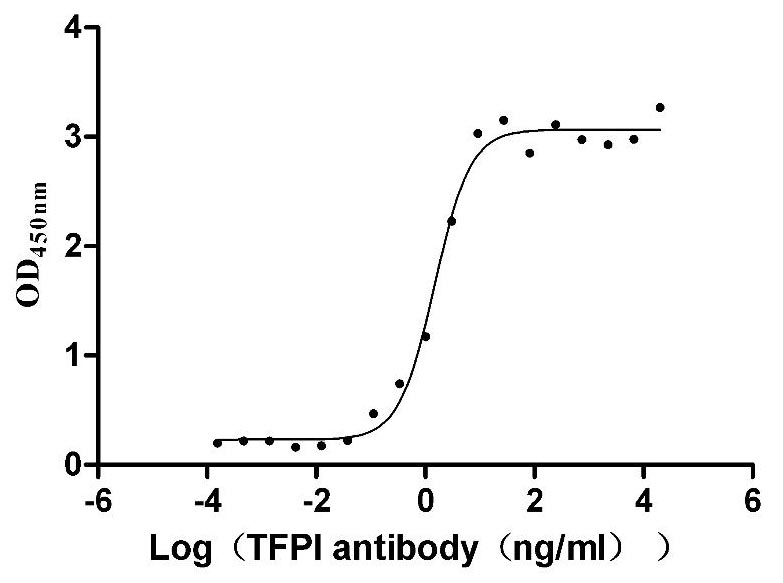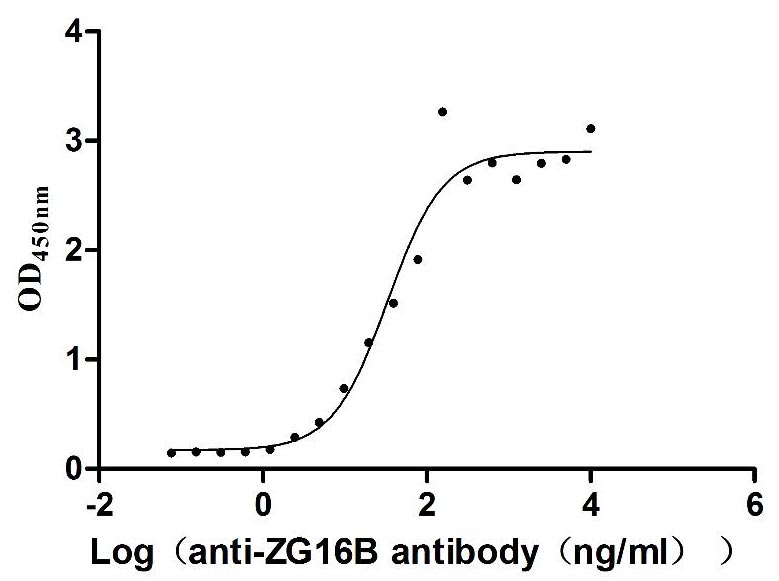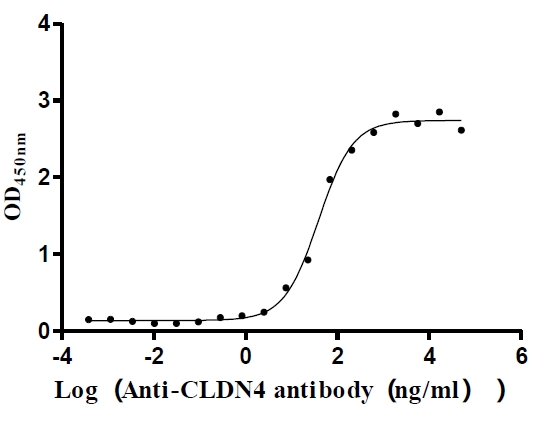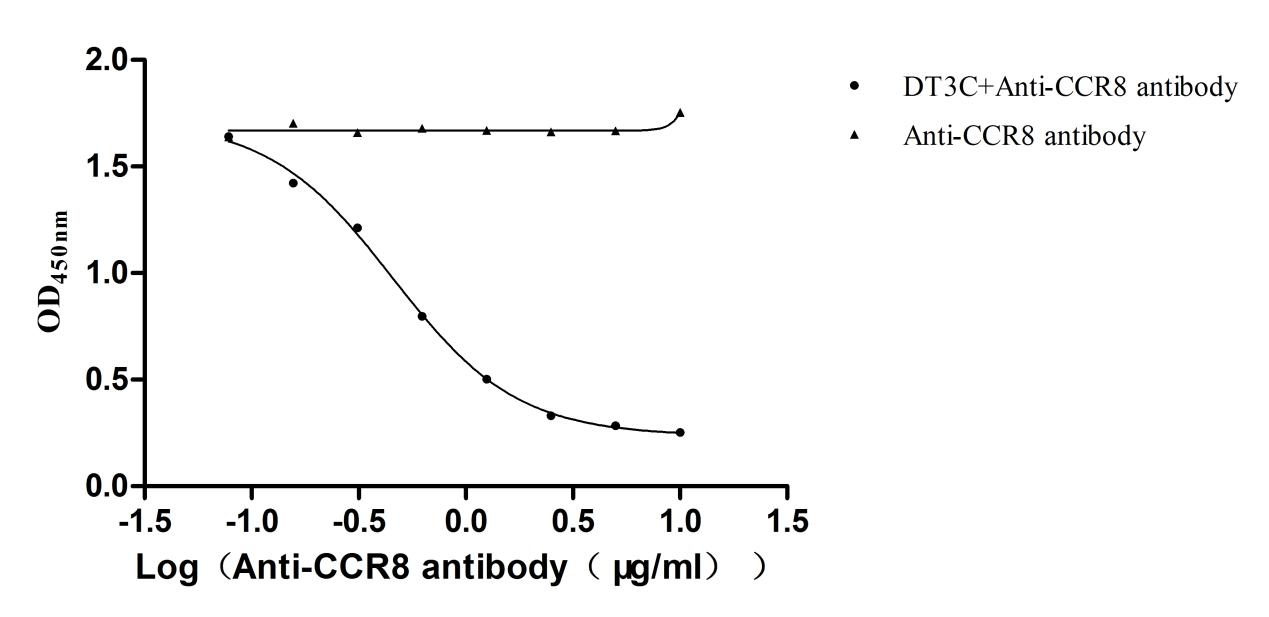Recombinant Mouse C-X-C motif chemokine 10 protein (Cxcl10)
In Stock-
中文名稱:Recombinant Mouse C-X-C motif chemokine 10 protein(Cxcl10) (Active)
-
貨號:CSB-AP001141MO
-
規格:¥852
-
圖片:
-
其他:
產品詳情
-
純度:>97% as determined by SDS-PAGE.
-
內毒素:Less than 1.0 EU/μg as determined by LAL method.
-
生物活性:Fully biologically active when compared to standard. The biologically active determined by a chemotaxis bioassay using human peripheral blood lymphocytes is in a concentration range of 0.1- 10.0 ng/ml in the presence of IL-2.
-
基因名:
-
Uniprot No.:
-
別名:Cxcl10; Crg2; Ifi10; Inp10; Scyb10C-X-C motif chemokine 10; 10 kDa interferon gamma-induced protein; Gamma-IP10; IP-10; C7; Interferon-gamma induced protein CRG-2; Small-inducible cytokine B10
-
種屬:Mus musculus (Mouse)
-
蛋白長度:Full Length of Mature Protein
-
來源:E.Coli
-
分子量:8.7 kDa
-
表達區域:22-98aa
-
氨基酸序列IPLARTVRCN CIHIDDGPVR MRAIGKLEII PASLSCPRVE IIATMKKNDE QRCLNPESKT IKNLMKAFSQ KRSKRAP
-
蛋白標簽:Tag-Free
-
產品提供形式:Liquid or Lyophilized powder
Note: We will preferentially ship the format that we have in stock, however, if you have any special requirement for the format, please remark your requirement when placing the order, we will prepare according to your demand. -
緩沖液:0.2 μm filtered 2×PBS, pH 7.4 ,lyophilized
-
儲存條件:Store at -20°C/-80°C upon receipt, aliquoting is necessary for mutiple use. Avoid repeated freeze-thaw cycles.
-
保質期:The shelf life is related to many factors, storage state, buffer ingredients, storage temperature and the stability of the protein itself.
Generally, the shelf life of liquid form is 6 months at -20°C/-80°C. The shelf life of lyophilized form is 12 months at -20°C/-80°C. -
貨期:5-10 business days
-
Datasheet & COA:Please contact us to get it.
相關產品
靶點詳情
-
功能:Pro-inflammatory cytokine that is involved in a wide variety of processes such as chemotaxis, differentiation, and activation of peripheral immune cells, regulation of cell growth, apoptosis and modulation of angiostatic effects. Plays thereby an important role during viral infections by stimulating the activation and migration of immune cells to the infected sites. Mechanistically, binding of CXCL10 to the CXCR3 receptor activates G protein-mediated signaling and results in downstream activation of phospholipase C-dependent pathway, an increase in intracellular calcium production and actin reorganization. In turn, recruitment of activated Th1 lymphocytes occurs at sites of inflammation. Activation of the CXCL10/CXCR3 axis plays also an important role in neurons in response to brain injury for activating microglia, the resident macrophage population of the central nervous system, and directing them to the lesion site. This recruitment is an essential element for neuronal reorganization.
-
基因功能參考文獻:
- This study explored the effect of CXCL10 on COPD induced by cigarette smoke (CS) and its underlying mechanism. PMID: 30118441
- CXCL10, not CXCL9 or CXCL11, induced IL-9 expression in the liver tissue. PMID: 29860220
- in vivo experiments show that the CXCL10/CXC chemokine receptor family 3 axis prevents the recruitment of macrophages, reduces inflammation, and halts the progression of the disease; the increased production of IL-1beta highlights the autoinflammatory nature of congenital hepatic fibrosis and may open novel therapeutic avenues PMID: 29140564
- CXCL10 and blood-brain barrier permeability enhancement in rabies virus infection PMID: 26895109
- Study shows that circulating interferon- that binds to receptors on brain endothelial cells and induces Cxcl10, is a central link in the signaling chain eliciting inflammation-induced aversion. PMID: 28864260
- The knockout of either CXCL10 or TNF-alpha reduced germ cell apoptosis in the co-cultures of germ cells and Sertoli cells in response to MuV infection. Local injection of MuV into the testes of mice confirmed the involvement of CXCL10 in germ cell apoptosis in vivo. PMID: 29072682
- CXCL10 has strong inhibitory effects on neovascularization, whereas MMP13 is required for neovascularization in C. albicans-infected corneas. PMID: 28623423
- Results suggest that CXCL10(-/-) mice are protected against diet-induced nonalcoholic steatohepatitis (NASH), in an obesity-independent manner. PMID: 27349927
- In conclusion, upregulated CXCL10 in steatohepatitis impairs autophagic flux by reducing autolysosome formation, thereby inhibiting autophagic protein degradation and the accumulation of ubiquitinated proteins, leading to the development of steatohepatitis. PMID: 28824718
- These findings highlight the importance of CXCL10 signaling in the pathogenesis of rheumatoid arthritis and provide previously unidentified details of the mechanisms by which CXCL10 promotes the development of arthritis. PMID: 28724396
- Study revealed that CXCL10 evoked an ionic current mainly carried by Cl(-) channels, suggests that Cl(-) channels are likely key molecular candidates responsible for the CXCL10-evoked neuronal activation and itch-like behaviors in a murine model of allergic contact dermatitis induced by the antigen squaric acid dibutylester. Cl(-) channels may emerge as a promising drug target for the treatment of allergic itch. PMID: 28446581
- Collectively, these results suggest that the CXCL10/CXCR3-mediated NF-kappaB signaling pathway plays a role in the control of autonomous regulation of CXCL10 and malignant tumor properties in breast cancer 4T1 cells. PMID: 28209986
- In lipotoxic hepatocytes, MLK3 activates a MAPK signaling cascade, resulting in the activating phosphorylation of STAT1, and CXCL10 transcriptional upregulation. PMID: 28262979
- These findings elucidate an NFAT-MAPK signaling paradigm for induction of isletokine expression in beta-cells and reveal IP-10 as a primary therapeutic target to prevent beta-cell-induced inflammatory loss of graft function after islet cell transplantation. PMID: 28855240
- A novel function of CXCL10 in mediating monocyte production of proinflammatory cytokines in inflammatory bowel diseases has been described. PMID: 28899907
- CXCL10 chemokine levels correlate negatively with gremlin-1 levels in mouse and human lung. PMID: 27428020
- Increased CXCL10 expression led to decreased tumour burden and malignant ascites accumulation in the ID8 syngeneic murine model of HGSC. PMID: 28318643
- CXCL10 plays in the pathogenesis of recurrent Herpetic stromal keratitis, and that CXCL9 displays its importance when CXCL10 is absent. PMID: 28282568
- PERK and IRE1alpha/XBP1 in the unfolded protein response differentially regulate the expression of CXCL10 and CCL2 likely through modulation of ER stress-induced NF-kappaB RelA and STAT3 activation. PMID: 28065589
- CXCL10 might influence the cellular composition locally in the islet graft, thereby playing a role in the autoimmune destruction. CXCL10 might therefore constitute a potential therapeutic target to prolong islet graft survival PMID: 27797910
- Data provide first evidence for a link between oncogenic JAK2V617F signaling and cell intrinsic induction of CXCL10 induced by activated NFkB signaling. PMID: 28233092
- Donor interleukin-22 and host type I interferon signaling pathway participate in intestinal graft-versus-host disease via STAT1 activation and CXCL10. PMID: 26153763
- The results suggested that astrocytes contribute to Cerebral Malaria pathogenesis by producing CXCL10 in response to IFN-gamma and LT-alpha. PMID: 26687629
- MiR-15a contributes abnormal immune response in myasthenia gravis by targeting CXCL10 PMID: 26845678
- During hepatocyte lipotoxicity, activated MLK3 induces the release of CXCL10-bearing vesicles from hepatocytes, which are chemotactic for macrophages. PMID: 26406121
- Neutrophils and inflammatory monocytes were identified as the main cellular sources of CXCL10 responsible for the induction of these processes PMID: 26718341
- IP-10-treated mice exhibited reduced alkali-induced CrNV through decreasing intracorneal VEGF and bFGF expression, and inhibiting endothelial cell proliferation and tube formation. PMID: 25309995
- Studied whether CXCL10 can inhibit the growth of cervical cancer; results show CXCL10 could reduce the level of HPV E6 and E7 in cervical cancer cells; in vivo study showed that CXCL10 could inhibit the growth of tumor in the immunodeficiency mice. PMID: 19257857
- hepatic expression of the inflammatory CXC chemokine ligands (CXCL)9 and CXCL10 strongly increased whereas homeostatic CXCL12 significantly decreased. PMID: 26052942
- The mesangial cell apoptosis observed in this mesangial proliferative glomerulonephritis model was related to CXCL10 expression induced by Mxi1 inactivation. PMID: 25683914
- CXCL10 plays a pivotal role in the pathogenesis of experimental steatohepatitis. PMID: 25048951
- The chemokines monocyte chemotactic protein 1 (MCP1), MIP1alpha, MIP1beta, interferon gamma-induced protein 10 (IP-10), and eotaxin were induced in Saa1 TG mice. PMID: 25847238
- tumours are characterized by expression of inflammatory chemokines (CCL2, CCL5, CCL7, CCL8, CCL12, CXCL9, CXCL10 and CX3CL1), reflected by an enrichment of activated Foxp3(-) and Foxp3(+) T cells PMID: 25495686
- These findings have implications for the role of CXCL10 as an important mediator during the initiation of neuroinflammatory processes associated with oligodendrocyte pathology. PMID: 25725102
- We demonstrated the overexpression of genes coding for CXCL10 in murine astrocytes infected with Theiler's murine encephalomyelitis virus PMID: 25052192
- Data show that testosterone treatment of female mice significantly reduced the expression of interleukin 17A (IL-17A), chemokines CXCL-9 and CXCL-10 within the liver. PMID: 25672751
- Data indicate that C-X-C motif chemokine 10 (CXCL10) expression was increased in the inflammation of C protein-induced myositis (CIM) model and its blockade suppressed inflammation in muscle. PMID: 24939012
- In rabies, CXCL10 initiates the cascade leading to activation of microglia/astrocytes, infiltration of inflammatory cells, expression of chemokines/cytokines, reduction of tight junction proteins expression, and blood-brain barrier permeability increase. PMID: 25339777
- IP-10 levels were measured to test epithelial secretion in cytic fibrosis. PMID: 23977293
- This study demonistrated that astroglial CXCL10 enhances spinal cord perivascular CD4+ lymphocyte accumulation and acute spinal cord demyelination in MOG peptide experimental autoimmune encephalomyelitis. PMID: 24924222
- data indicate that epithelium-expressed CXCL10 plays a critical role in fungal clearance and that CXCR3-expressing NK cells contribute to CA eradication in mouse corneas. PMID: 24965580
- WT1 regulates the expression levels of Cxcl10 and Ccl5 in epicardial cells directly and indirectly through increasing the levels of IRF7. PMID: 23900076
- we found that IRF1 was essential for IL-1-induced expression of the chemokines CXCL10 and CCL5 PMID: 24464131
- Bone marrow-derived CXCL10 and tissue-derived CXCL10 play a critical role in accelerating perfusion recovery after arterial occlusion in mice probably by promoting vascular smooth muscle cell recruitment and maturation of pre-existing anastomoses. PMID: 24407030
- We report in this article that CXCL10 plays a role in CD8+ T cell priming PMID: 23940275
- Hypersensitivity of Usp18 knockout in mammary epithelial cells to IFN-gamma enhances Cxcl10 expression and protects against mammary tumour progression. PMID: 23681607
- Endogenous CXCL10 contributes to recruit the primary neutrophil influx and to affect the expression of cytokines, chemokines, and angiogenic factors as well as to reduce the viral titer and herpes stromal keratitis severity. PMID: 23720717
- Enterovirus 71 (EV71) infection boosts IP-10 expression to increase gamma interferon and gamma interferon (Mig) levels, infiltration of CD8 T cells, virus clearance in tissues and the survival of mice. PMID: 23288420
- CXCL10 is directly involved in the generation of a parasite specific CD8+ T cell-mediated immune response. PMID: 23144947
- This study demonstrates that central nervous system-expressed CXCR3 ligand CXCL10 is the critical chemokine regulating antibody-secreting cell accumulation during coronavirus-induced encephalomyelitis. PMID: 23302888
顯示更多
收起更多
-
亞細胞定位:Secreted.
-
蛋白家族:Intercrine alpha (chemokine CxC) family
-
組織特異性:Expressed in the spleen, thymus, lymph nodes and liver. Expressed in astrocytes, microglia, and neurons.
-
數據庫鏈接:
Most popular with customers
-
Recombinant Human Receptor tyrosine-protein kinase erbB-2 (ERBB2), partial (Active)
Express system: Mammalian cell
Species: Homo sapiens (Human)
-
Recombinant Human Tissue factor pathway inhibitor (TFPI), partial (Active)
Express system: Mammalian cell
Species: Homo sapiens (Human)
-
Recombinant Human Pancreatic adenocarcinoma up-regulated factor (ZG16B) (Active)
Express system: Mammalian cell
Species: Homo sapiens (Human)
-
Recombinant Human Claudin-4 (CLDN4)-VLPs (Active)
Express system: Mammalian cell
Species: Homo sapiens (Human)
-
Recombinant DT3C (Diphtheria toxin & spg 3C domain) for Antibody Internalization Assay (Active)
Express system: E.coli
Species: N/A

